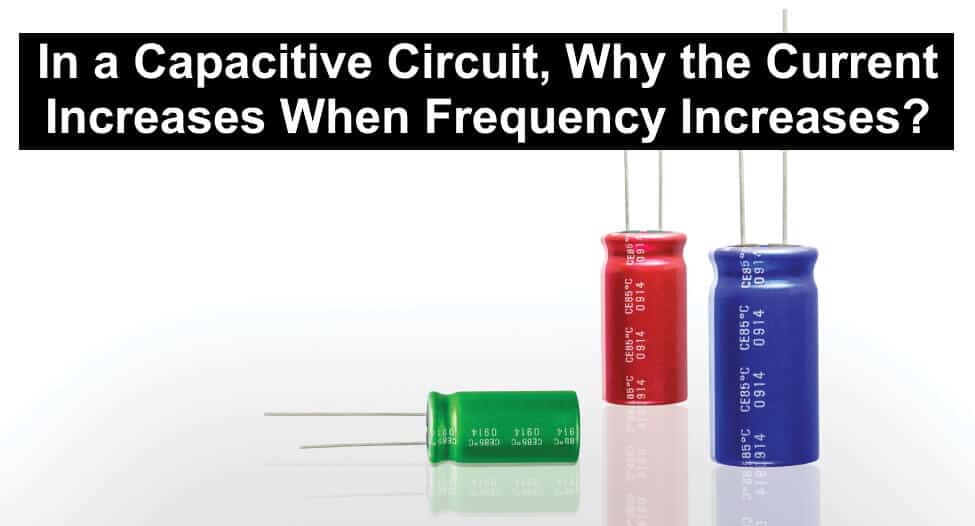Why the Current (I) Increases, When Frequency Increases in a Capacitive Circuit & Vice Versa?
Another question from electrical and electronics engineering interviews question and answers series.
Explain the statement that “In a capacitive circuit, why the circuit current increases when frequency increases“.
Related Questions:
- Why Current Increases When Capacitance Increases or Capacitive Reactance Decreases?
- Why Current Decreases When Inductance or Inductive Reactance Increases?
Explanation:
We know that in DC circuits:
I = V / R,
But in case of AC circuits:
I = V / Z
Where “total resistance of AC circuits = Impedance = Z = √ (R2 + (XL – XC2)”
In case of a capacitive circuit:
- Z = √ (R2 + XL2)
- I = V / XC or I = V / Z
It shows that in a capacitive circuit, Current is directly proportional to the capacitance “C” and inversely proportional to the capacitive reactance as capacitance and capacitive reactances “XC” are inversely proportional to each others.
Related Questions:
- Which Transformer is More Efficient When Operates on 50Hz or 60Hz?
- Can We Operate a 60Hz Transformer on 50Hz Supply Source and Vice Versa?
- Is it Possible to Operate a 50Hz Transformer on 5Hz or 500Hz Frequency?
Let’s check with an example to see how current increases by increase in frequency in case of a capacitive circuit.
When Frequency = 5 µF
Suppose a capacitive circuit where:
- Voltage = V = 3000 V
- Capacitance = C = 5 µF
- Frequency = f = 50 Hz
To find the capacitive reactance;
XC = 1 / 2πfC
XC = 1 / (2 x 3.1415 x 50 x 5×10-6)
XC = 636.94 Ω
Now, current in the capacitive circuit:
I = V / XC
I = 3000 V / 636.94 Ω
I = 4.71 A
Related Questions:
- Why Power Factor Decreases When Inductance or Inductive Reactance Increases?
- Why Power Factor Decreases When Capacitive Reactance Increases or Capacitance Decreases?
When Frequency = 60 Hz
Now we increased the frequency form 50Hz to 60Hz.
V = 3kV, C = 5 µ Farads, f = 60 Hz.
XC = 1 / 2πfC = 1 / (2 x 3.1415 x 60 x 5×10-6) = 530.63Ω
I = V / XC = 3 kV / 530.63Ω
I = 5.65 A
Conclusion:
We can see that, When frequency was 50Hz, then the circuit current were 4.71 A,
But when circuit frequency increased from 50Hz to 60Hz, then the current increases as well from 4.71 A to 5.65 A.
Hence proved,
In a capacitive circuit, when frequency increases, the circuit current also increases and vice versa.
f ∝ I
In oral or verbal,
- Capacitive reactance is a kind of resistance. When resistance increases, the circuit current decreases and vice versa.
- Capacitance is inversely proportional to the capacitive reactance and frequency.
C ∝ 1 / XC and C ∝ 1 / f
- Current is directly proportional to the capacitance and inversely proportional to capacitive reactance and impedance.
I ∝ C and I ∝ 1 / XC and I ∝ 1 / Z
- Impedance is directly proportional to the capacitive reactance
Z ∝ XC
- In a capacitive circuit, Frequency is directly proportional to the current.
I ∝ f
Related Questions/Answers:
- According to Ohm’s Law, I ∝ V, But I ∝ 1/V in Power Equation. How do you Explain?
- Why Flux in Primary and Secondary Winding is Always Equal?
- Why Power in Pure Inductive and Pure Capacitive Circuit is Zero?
- Why the reactance of a system under fault condition is low and faults currents may raise to the dangerously high value?
- Why Inductive Reactance (XL In DC Supply Is Zero (0)?
- Which One is More Dangerous? 50Hz or 60Hz in 120V/230V & Why?
- Why Can’t a 12V Car Battery Electrocute You?
- Which One is More Dangerous? 120V or 230V and Why?
 Why Do Doorbells Use Low Voltage of 12V-24V AC Instead of DC?
Why Do Doorbells Use Low Voltage of 12V-24V AC Instead of DC? Why Does an Electric Tester Not Work in DC Circuits?
Why Does an Electric Tester Not Work in DC Circuits? Why Do The Positive And Negative Wires Spark When Touched?
Why Do The Positive And Negative Wires Spark When Touched? What are the Cuts on the Rotor of Motor’s Armature?
What are the Cuts on the Rotor of Motor’s Armature? Why Do Wind Turbines Have 3 Blades Instead of 2 or 5?
Why Do Wind Turbines Have 3 Blades Instead of 2 or 5? Difference Between Edge Triggering and Level Triggering
Difference Between Edge Triggering and Level Triggering